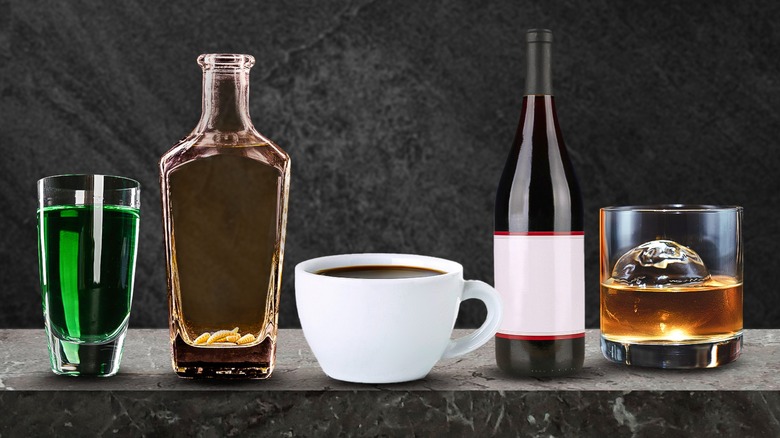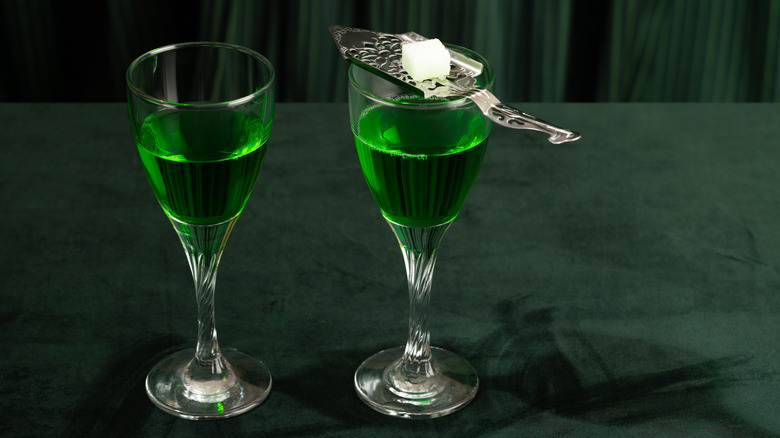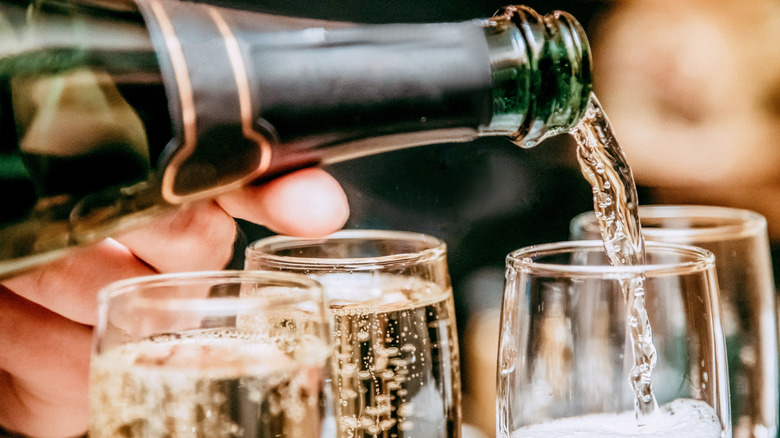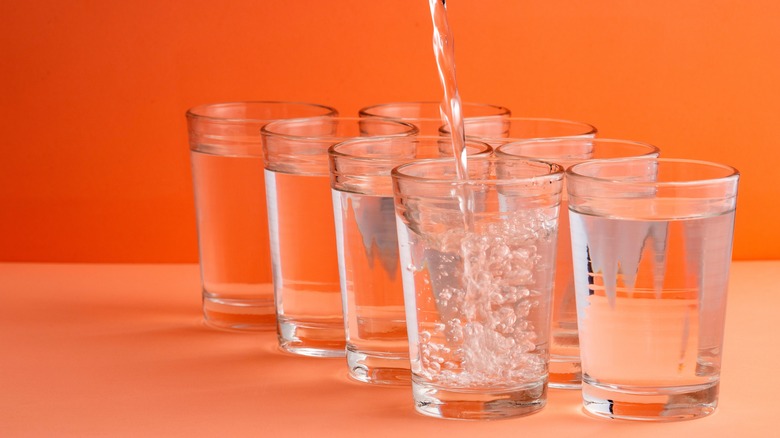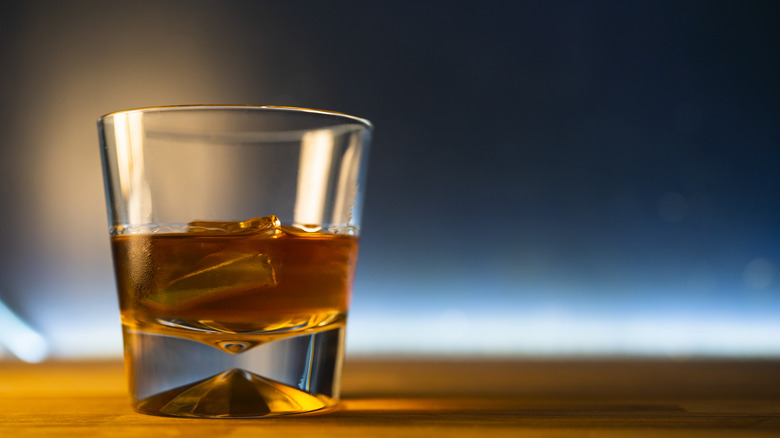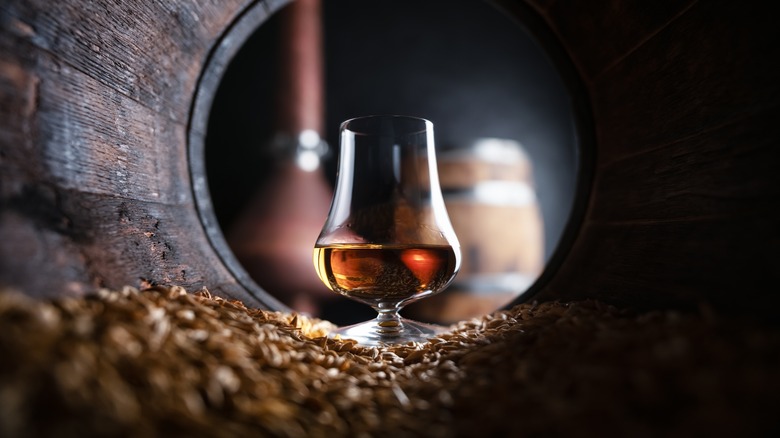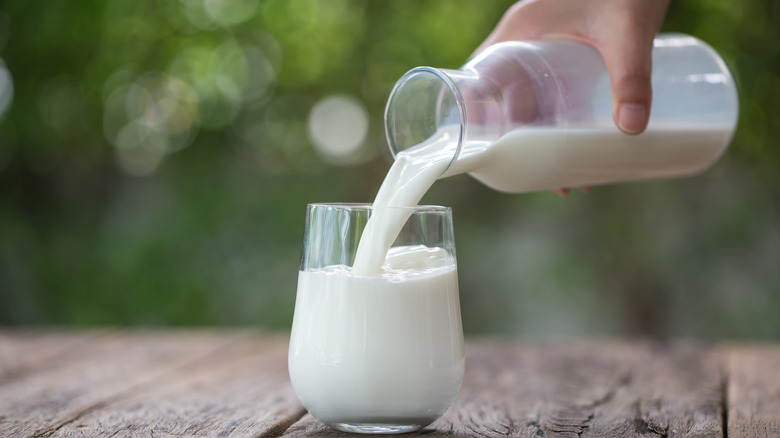10 Drink Myths So Wrong, They're Kind Of Iconic
We may receive a commission on purchases made from links.
Some bits of foodie wisdom are so often repeated that many of us just kind of accept them to be true. When we hear them repeated online and even in pop culture references and movie scenes, why would we question them? It turns out that we absolutely should question them, because in some cases, we're repeating so-called facts that are both untrue, and causing us to miss out on some seriously good stuff.
Let's take, for example, the widespread belief that sweet wines should be relegated to being dessert wines. That's an absolute myth — along with the idea that they're somehow less complex, versatile, and less deserving of respect than dry wines. Sweet wines definitely have a place alongside many meals, and if you're giving them a miss and serving some dry, room-temperature red wine, well, it turns out you're doubling down on the misconceptions.
So, let's clarify some things. You might find yourself expanding your horizons a bit, trying some things you've steered clear of before, serving things a little differently, and maybe even becoming a little more knowledgeable about how and what to order at a restaurant. From whiskey and wines to coffee and even milk, there's a lot of misinformation floating around out there, but we can help.
Tequila has worms in the bottles
You've probably heard the claim that tequila comes with a worm in the bottle, but the biggest misconception about tequila worms is right in the name. That weird-looking creature in some bottles isn't a worm at all, and it's not in tequila. Ever.
It's some types of mezcal that are bottled with that little critter inside, the difference between tequila and mezcal comes down to what they're made from: You'll see bottles of tequila confirming it's at least 51% blue agave, and that's a stipulation that doesn't apply to mezcal. It's a little unclear just why these so-called worms started getting put into mezcal, but it's believed — somewhat ironically — that it was initially done to raise a bit of awareness about the fact that mezcal is a spirit that's rather different from tequila. Even the best-laid plans can go terribly wrong, and here we are.
Finally, we said it's not a worm, and it's not. Those little guys are actually called gusano de maguey, and they're the larvae of a few different types of moths and butterflies. For anyone who's been dared to eat the creature in the bottle, you're not doing anything new, original, or the least bit dangerous: These larvae have been a major food source since the time of the Aztecs. They're still commonly harvested (from the same agave plants mezcal is made from), then dried and turned into seasonings, or added to all kinds of dishes from mole to tacos.
Your morning coffee is contributing to dehydration
Anyone who starts the day with a cup of joe (or a few) has probably been reminded at some point that coffee will dehydrate you. If you're trying to keep track of your fluid intake, it's possible that you've even heard that coffee doesn't count at all toward hydration. The good news is that's mostly wrong, and it's an idea that's partially rooted in a very small, not-at-all scientific study done back in the 1920s.
Fortunately, more research has been done, and here's what's going on. Caffeine can, in fact, dehydrate you, as it interferes with the way your body processes sodium and excretes more of it than usual. That seems to support the dehydration theory, but you have to consume such high levels of caffeine that, unless you're drinking a lot of coffee very, very quickly, it's generally not an issue.
Studies vary on just how much coffee you'll have to drink to worry about dehydration. One study from the University of Birmingham's School of Sport and Exercise Sciences found that drinking three to six cups of coffee a day has no dehydrating effects. Others put the line at around five cups of coffee a day, and it kind of makes sense: Everyone's a little different, after all. However, the bottom line is that dehydration isn't a worry with moderate coffee consumption — especially considering that coffee contains a lot of water.
Red wine needs to be served at room temperature
Whether you prefer your red wine paired with something like a classic rack of lamb or you'd rather enjoy a glass while you're prepping dinner, you've probably heard that red wine is best at room temperature. It's so often repeated that you might even have heard someone look down their nose at the idea of a chilled red, and yes — if you've had it happen to you, you completely understand what we mean when we say it's an expression you can hear.
Fortunately, experts agree that red wine shouldn't be served at room temperature, and you can definitely remind self-proclaimed, would-be sommeliers of that the next time you get that reaction to popping a bottle of red in the fridge. The idea goes back decades, to a time when wine was generally kept in cool cellars, and allowed to warm before it was opened. Now, homes are warmer, we're more comfortable when we have the heat on, and those room-temperature reds are too warm.
Depending on the type of red, it's generally agreed that the ideal temperature is between 55 and 68 degrees Fahrenheit, which is probably cooler than the room temperature of many homes. A red that's too warm will taste heavy — and heavy on the alcohol content — while a cooler red will be more well-balanced, more aromatic, and you'll be able to detect more delicate flavors that get lost when the glass is too warm.
Absinthe is hallucinogenic
To say that absinthe has a bit of a reputation is putting it lightly, as this bright green liquor has been oft-touted as causing hallucinations and psychedelic visions at the very least, and at the worst, it's been said to drive people to kill. Artists and writers from Van Gogh to Hemingway — and perhaps most famously, Oscar Wilde — were associated with the idea of creative minds tapping into something otherworldly with the help of absinthe, and in 1905, a man named Jean Lanfray killed his wife and children after a day spent drinking absinthe, wine, brandy, and more wine.
It was that incident that really kicked off the crusade against absinthe, and it was banned in many countries. Fortunately for those who love that unique anise flavor, we know now that there's absolutely nothing to any of the accusations and legends.
When absinthe fear was at its height, doctors blamed wormwood oil and later, a compound called thujone. Thujone in high doses has been linked to hallucinations, seizures, vomiting, and anxiety-like symptoms, but the thujone content of absinthe is so low that it can legally be described as thujone-free.
Keep Champagne (or sparkling wine) bubbly with a spoon
The best part of Champagne and sparkling wine is the bubbles, so we admit we want to believe that you can preserve those bubbles by putting a spoon in the neck of the bottle. It just doesn't work, though, and there have been actual studies done on whether or not an opened bottle of Champagne retains more bubbles with the help of a spoon. Who says science isn't fun?
Champagne's fizz disappears as those bubbles are released into the air, and whether or not there's a spoon in the way, that doesn't matter. The good news is that these studies have also determined that simply using a stopper is enough to keep sparkling wines mostly fizzy for a few days. Alternately, there are a lot of great uses for leftover Champagne, from turning it into ice cubes to adding it to salad dressing or even using it in your skin care routine.
Everyone should aim for drinking eight glasses of water a day
Hydration is important. Signs that you're getting dehydrated include exhaustion, dizziness, confusion, and, in extreme cases, a fever, lethargy, and feeling like you just need to go to sleep. Our modern world has a ton of tools to help us monitor our fluid intake, and yes, there are definitely apps for that. We're constantly told that eight glasses of water a day are necessary for adequate hydration, but it turns out that's a myth that was kind of debunked from the very beginning.
In 1945, the Food and Nutrition Board of the National Research Council determined that most adults need 2.5 liters of water per day. That translated to eight glasses, and here we are. The thing is, though, that even that original paper explained that quantity included liquids from food — so it's a great example of why you should read advice in its entirety before you start repeating it.
How much water you actually need varies a lot, and there are no actual guidelines that are set in stone. It depends a lot on the person, and is influenced by things like age, activity, how hot or cold your environment is, what kinds of food you eat (and how much water they contain), and what other kinds of beverages you drink.
Bourbon was named for Bourbon County, Kentucky
We humans like it when things are simple, straightforward, and logical. Bourbon is most strongly associated with Kentucky, thanks to things like a long history of production and promotion, with tours like the massive Kentucky Bourbon Trail, an experience that can take anywhere from a week to a month to complete. You've probably heard that this particular spirit is called bourbon because of this connection, and specifically, it's supposed to be a reference to Bourbon County. It's even a claim you'll hear at distilleries and on that aforementioned Kentucky Bourbon Trail, but bourbon historians say that it's simply not true.
Michael R. Veach is the author of "Kentucky Bourbon Whiskey: An American Heritage." According to him, the name predates that story by at least two decades, and Veach says it's more likely that the name came from a different locale: the famous Bourbon Street in New Orleans.
New Orleans was one of the first markets for the new spirit coming out of Kentucky, as early pioneers believed that French settlers would appreciate the liquor's Cognac-like flavor. It ended up being a huge market for this new drink, and Veach explained to Smithsonian Magazine: "People started asking for 'that whiskey they sell on Bourbon Street,' which eventually became 'that bourbon whiskey.'"
Scotland is definitely the birthplace of whiskey
If you've ever repeated the idea that whiskey was invented in Scotland, we hate to break it to you, but it's not that easy. The origins of what we know as whiskey today go back to that part of history where things start to get a little hazy, but historians have been able to make some discoveries about those early days of whiskey-making.
While it's not clear just when whiskey was first made, we do know that the first time whiskey-making was referenced in a Scottish historical document was a mention from 1494. Hop over to Ireland, though, and we have a 1405 document that mentions whiskey. But, you might say, it was probably being made long before it was being written about, and that's legit. Still, it's believed that when Scottish monks started making it, they were inspired by the processes that they learned from the Irish. To make things slightly more complicated, there are also records from 1174 that are believed to reference Henry II finding the Irish making aqua vitae, which is believed to have been a whiskey-like spirit.
There's another contender in the mix, too, and that's the Vikings. That theory suggests that Vikings learned about the process of distillation while traveling in the Middle East, and that all adds up to the fact that no one really knows for sure.
Raw milk is better for you than pasteurized
The pasteurization process is the result of a long series of experiments first associated with France's wine industry, and the findings were a huge deal. Britain's Royal Society named Louis Pasteur's process as one of the most important innovations in food history, but listen to groups like the Raw Milk Institute, and you might hear all about how raw milk is supposedly better. It's touted as being easier to digest than pasteurized, and that it's much healthier, has more nutrients, is better for gut health, and can even help prevent the development of allergies.
More mainstream science says that absolutely none of the claims are true. It has long been known that pasteurization does not destroy all the nutrients and vitamins in milk, and even more importantly, the process makes it safe to drink. Bacteria and microbes are introduced into milk as soon as it comes out of the cow; it's pretty much unavoidable. (You've seen where udders are located, right?) Pasteurizing gets rid of potentially dangerous bacteria, and it's so important that in some countries — including Canada — raw milk is illegal.
The science is pretty certain of this one, and that includes one study into the raw milk issue that was published in the Journal Emerging Infectious Diseases back in 2017. The study compiled data on dairy-related foodborne illnesses and hospitalizations between 2009 and 2014, and determined that 96% were due to unpasteurized products.
The second-cheapest wine at a restaurant always has the highest markup
There are a lot of great tips out there on how to order wine at a restaurant, but it turns out that one of the most often repeated bits of advice is one that you shouldn't believe. That's the idea that you should never order the second cheapest bottle on the menu, and the reasoning goes like this: People will skip the cheapest and buy the slightly more expensive alternative, and restaurants know this — and they'll mark this bottle up more.
That's a pretty cynical way of looking at things, and according to experts who have compared hundreds of restaurant menus, wine prices, and markups, it's just not true. In fact, if you're worried about avoiding the wines that are marked up the most, you're in the wrong part of the menu. One 2021 study from the American Association of Wine Economists found that the wines that tended to have the highest mark-ups were the mid-range ones. That, however, is not always the case, and it's also likely that if a restaurant has a house wine, that's the one that's going to come with a hefty mark-up. Again, there are all kinds of factors at play here, but if you're staying away from the second-cheapest wine because you think it's a bad buy, don't: Perhaps the better way to look at it is not to worry about mark-ups, and instead get something you're going to enjoy.
